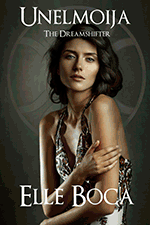Luxury Travel Review

Safari properties that offered exercise facilities among favorites
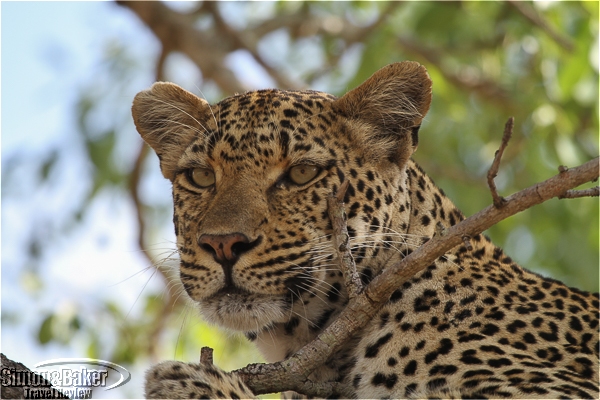
A leopard in a tree during a game drive at Rattray’s on MalaMala

The pool at Ratttray’s had a view of the dry river bed
When on safari the repetitive cycle of daily game drives and copious meals can leave us tired without the healthful benefits of exercise. On our most recent itinerary featuring safari properties in Botswana, Namibia and South Africa two lodges stood out for their fitness and pool features. Both lodges, within the Sabi Sand Reserve, a private reserve adjacent to South Africa’s Kruger National Park, had private plunge pools in the rooms as well as a main area swimming pool large enough to swim short laps.

The exercise room at Rattray’s

A white rhino during a game drive at Rattray’s
In the Mala Mala Reserve, Rattray’s on MalaMala had a dedicated fitness room for guests with exercise equipment and a few weights. Next to the fitness room there was a sauna. In front of the fitness room there was a swimming pool. Both had expansive views of the lawn and dry river bed. In addition, there were private plunge pools on the river facing deck of each spacious room.
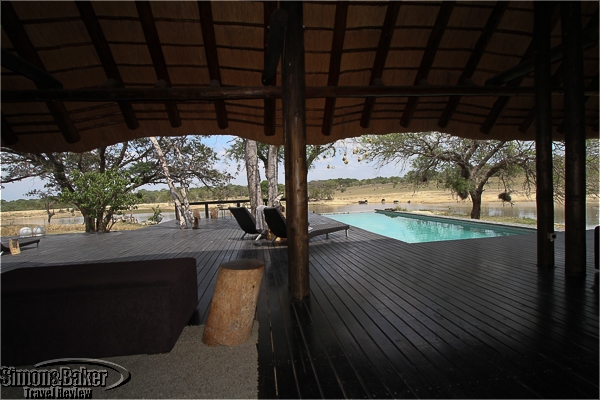
The main pool at Chitwa Chitwa Private Game Lodge faced a dam

From the pool deck we observed elephants visiting the dam
Chitwa Chitwa Private Game Lodge, in the northern end of Sabi Sand Reserve, also had a dedicated workout room with electric exercise machines. The art filled sunlit room with glass walls was adjacent to the property’s dedicated spa treatment room. Guest rooms had private decks with bush and dam views as well as plunge pools. In the main area, there was a rimless swimming pool facing the property dam.
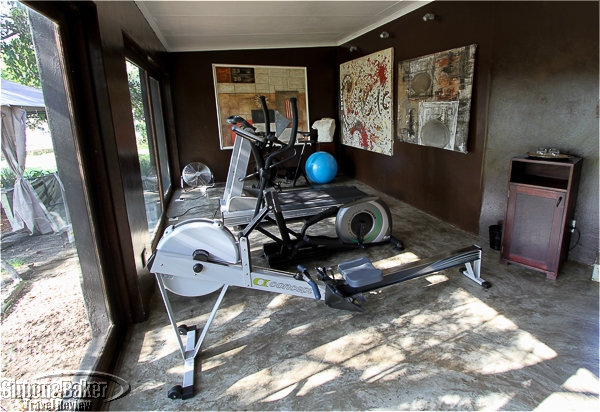
The exercise room at Chitwa Chitwa

A lion seen during a game drive at Chitwa Chitwa
In Franschhoek, La Residence offered luxury accommodations and superlative service
Article and photos by E. del Valle

The main building at La Residence

I had breakfast with Edward Morton, general manager of the hotel
I spent my final day in South Africa at La Residence, a serene, elegant and stylish farm estate in the village of Franschhoek, one of my preferred wine and gourmet areas of the country. The property and the setting were as pretty as I remembered from previous visits (see La Residence Hotel and Villas and La Residence).

Vineyard Suite 3 seen from the garden
I stayed in Vineyard Suite 3, a 40 square meter room with a private garden that faced the vineyards and mountain in the family section of the 30 acre estate with 85 employees. That part of the property, built in 2010, had five Family Suites. The farm grew grapes, olives, plums, quinces, black and green figs, pomegranates and lemons.
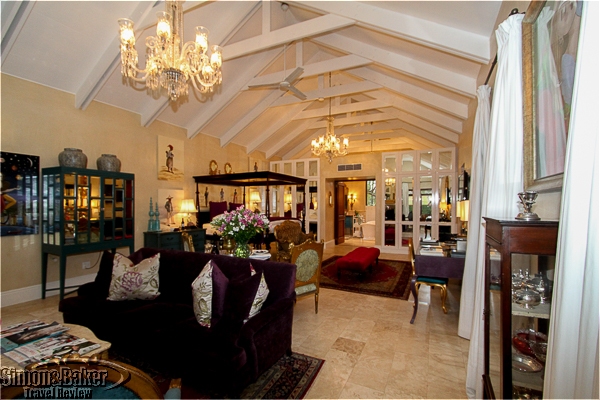
The interior of my room, Vineyard Suite 3

There was a bathtub in the center of the bathroom
The room, the smallest of the Family Suites, was lovingly decorated with fine fabrics, a large and beautiful fresh flower arrangement, original oil paintings, and comfortable and colorful furnishings. The four poster bed, with crisp white linen sheets embroidered with the brand initials and fluffy feather pillows, was so far off the ground there were three rung wood ladders on either side of the bed to climb up, not a favorite.

The hotel, situated in the middle of a vineyard, had pretty mountain views

Randall looked after me with warmth and attention to detail
A high ceiling and three chandeliers added to the sense of space. Throw rugs atop the stone flooring made it homey as did the ample closet space. The sunlit bathroom too was spacious and inviting, housing an oversize door-less shower, separate bathtub, a room for the toilet, and twin sinks, one on either side of the bathroom.
I especially enjoyed breakfast, a combination of a cold buffet, including skim and full cream milk, freshly harvested honey comb, seasonal fruit, locally sourced cheeses and homemade muesli, and made to order hot dishes. I also liked that staff were attentive and guest oriented. Randall, who looked after me, was friendly, helpful, and clearly knew the area well. He reconfirmed my airport transfer and my rental car pickup, and handled the check-in for my domestic flight with ease and efficiency.

I found chilled sparkling wine, fresh fruit, and flowers on arrival in my room

Liz Biden, co-owner and designer of La Residence, part of The Royal Portfolio
There were many complimentary amenities such as laundry, transfers within the village, a well stocked minibar, quality snacks and WiFi. Although I was able to go online, I was unable to send emails or connect to a VPN. There were some minor signs my room was due for a soft renovation. I appreciate the property’s elegant yet welcoming ambiance, farm setting with mountain views, comfortable and stylish decor, Villa Suites, and noteworthy service. La Residence (La Residence, Elandskloof Private Road, Elandskloof Farm, Franschhoek 7690, +27 21 876 4100, fax +27 21 876 2030, www.laresidence.co.za, info@laresidence.co.za, reservations@trp.travel), part of The Royal Portfolio owned by Liz and Phil Biden, remains among my favorite Franschhoek properties.
Why we liked seaside town on Florida west coast for quiet getaway
By Elena del Valle
Photos by Gary Cox

Dunedin mural on a wall
A skip and a jump (25 miles west) from Tampa, Florida we found Dunedin (Done-ee-den), a 28.2 square mile town with a population of just over 35,000 people. It had the unexpected small town feel of another place and time with unique shops and restaurants, picnic movies on the lawn on Friday nights, and a host of special events year round. The weekend we visited there were two street events, the American Classic Car Show Dunedin and Brewery Oktobeerfest.

The beginning of Main Street in Dunedin

The stage downtown hosted family movie night while we were there
The downtown core, half mile long, was six blocks of 15 restaurants and 53 shops on Main Street. The most salient feature on Main Street was the absence of block chain stores, restaurants and franchises. We stayed at the lovingly maintained Meranova Guest Inn and dined at The Black Pearl fine dining restaurant, both in the popular downtown section. Although 60 percent of the downtown buildings date back to circa 1900, construction peppered Main Street, promising fast approaching growth.

Decorated dolphins dotted Main Street

Bon Appetit restaurant faces the water at the end of main street
“Dunedin is very proud of the fact that 100 percent of the down town businesses are Mom and Pop owned,” said Bob Ironsmith, director, Economic and Housing Development, City of Dunedin. “This is the very reason that Dunedin maintains the quaint charming life style enjoyed by residents and guests.”

Once an hour boats ran from Honeymoon Island to Caladesi Island and back

A walkway to the beach

The beach in Caladesi State Park
More than half of the Pinellas County town, 17.8 square miles, is water and 10.4 square miles is land. Dunedin’s most celebrated ecotourism attractions were Caladesi Island State Park, a popular beach destination, and the undeveloped Honeymoon Island State Park, the state’s most visited park, offering bird watching, walking, biking and kayaking opportunities to residents and visitors. We visited both. It was necessary to take a boat from Honeymoon Island to Caladesi Island.

Inactive Osprey nests were visible all over Honeymoon Island

Peter H. Krulder, park manager, Honeymoon Island Administration, showed us around the island
Honeymoon Island averaged between 20 and 25 osprey nests and one eagle nest a year. Caladesi Island often had a few osprey nests and great horned owls a year. Domestic animals on a six foot hand held leash were welcome in the parks and only on one small section of the beach. They were not allowed in food service areas. Access to Caladesi Island was via two 45 foot long boats, one per hour, which took 20 minutes from Honeymoon Island to Caladesi Island.

We had lunch at the South Beach Pavilion Cafe on Honeymoon Island

The view from the pavilion
Honeymoon Island had four and a half miles of beach accessible to land visitors, 1,300 acres of uplands and 1,500 submerged acres. Caladesi Island had three miles of beach accessible to land visitors. Each island had hiking trails three mile long. It was no wonder the island parks were popular. More than one million people visit Honeymoon Island annually and 300,000 visit Caladesi Island. The parks are looked after by 12 fields staff and five administrative staff at Honeymoon Island plus five field staff at Caladesi Island.

We liked the fresh fish and a view of the ocean from the cafe
Although the surf was too choppy to swim it was fun walking around and exploring the long Caladesi Island beach. On our return from Caladesi Island a fresh fish lunch with a view of the beach on Honeymoon Island from the deck of the South Beach Pavilion Cafe (1 Causeway Boulevard, Dunedin, Florida 34698, https://www.romantichoneymoonisland.com/, +1 727 260-5503) was a treat. We enjoyed our visit to Dunedin (http://www.dunedingov.com) Main Street and both islands and would return for an event oriented or relaxing weekend getaway.
Boutique bed and breakfast offered intimate ambiance, creature comforts in central Franschhoek location
Article and photos by Elena del Valle

The outer gate at The Last Word Franschhoek
During a recent visit to the beautiful Franschhoek Valley in South Africa’s well known Winelands, I spent one night at The Last Word Franschhoek (68 Huguenot Street, Franschhoek 7690, South Africa, +27 021 876 4723, http://www.thelastword.co.za/en/home/, franschhoek@thelastword.co.za), a boutique bed and breakfast in the heart of the village of Franschhoek. Franklin Menloor, assistant manager, welcomed me on arrival and showed me around the 10-room boutique property owned by Peter Fleck and Nicky Coenen.

There was a 350 year old tree by the door

Franklin Menloor, assistant manager, showed me around the 10-room boutique property
I liked my homey second floor 35-square meter Superior Double Room facing the rear of the property and decorated in earth tones. Although I could hear neighborhood and street noises, considering its central location in the heart of the village it was relatively quiet. It had WiFi, comfortable and pretty cloth furniture, double curtains, a large Samsung flat screen television, and wall to wall carpeting. The temperature could be adjusted via underfloor heating and a remote controlled ceiling air conditioning and heating unit.

Room 7, my 35 square meter room with a sitting area
Room 7 was in the property’s new section built following a flood nine months prior to my visit. The modern room was on the second floor of the former private house facing the rear of the property parking area and a residential street. It was the first room at the top of the stairs that led from the living and dining areas of the bed and breakfast. It was adjacent to an open terrace that faced the intimate ground floor pool area. While it was too chilly to spend time poolside I loved the expansive view of the verdant surrounding mountains from the terrace.

My spacious and sunlit bathroom was spotless
Amenities included a slice of cream pie on arrival, a well stocked mini refrigerator and mini bar including a bottle of South African red wine, two red apples, snacks, and a hot beverages drawer with coffee pot, hot water pitcher, coffee and tea. Also included in the room rate were turn down sweets, like a small cup of crème brulee, and breakfast.
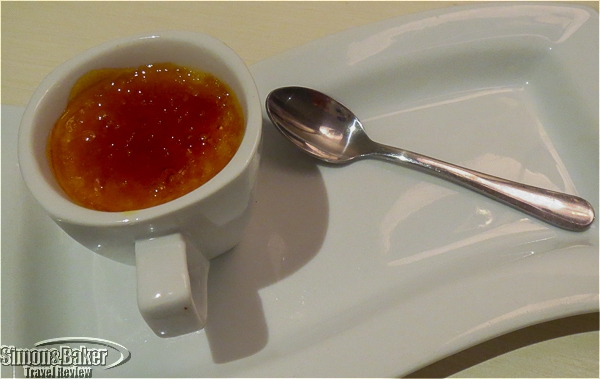
The creme brulee turn down snack

I liked the healing Earth toiletries
The large bathroom had: oversize door-less shower, water closet, separate bathtub, stool, twin sinks, and a built-in closet. During my stay, I tried Healing Earth South African made toiletries for the first time. In the light filled bathroom, there were 200 milliliter bottles of pleasantly scented shampoo, shower gel, conditioner, bath salts, and one small bar of soap. Fresh flowers and a handful of rose petals added a romantic touch.

The breakfast buffet
At breakfast there was a small buffet of pastries, jams, nuts, dried fruit, fruit in syrup, cereals, fruit juice, deli meats, cheese, crackers, salmon and avocado. It was also possible to order a hot made to order breakfast, which consisted of mostly egg options and pancakes. Sides for the egg dishes were sausage, bacon, mushrooms, tomato, and toast.
Pretoria Italian themed boutique property ideal for night before boarding The Blue Train
Article and photos by Elena del Valle

The Castello di Monte from the backyard
During my trip to South Africa I rode The Blue Train, a modern luxury vessel that journeyed several times a month between Pretoria and Cape Town and back. My train departed from Pretoria early in the morning (the luxury rail company boarding instructions indicated I should be at the Pretoria train station at 7:30 a.m.) which meant I would need to spend the previous night nearby or risk missing the train. At the same time, I knew traffic in the Gauteng region, where Johannesburg and Pretoria, two of the country’s major cities, are located, would be heavy at rush hour.
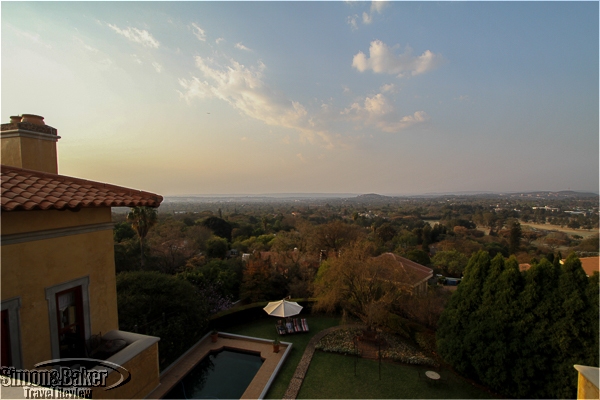
A view of my room on the left, the swimming pool and backyard in the foreground and Pretoria in the background
I wanted to spend the night before my departure close enough to reach the Pretoria station easily in the morning. At the same time, I sought a safe abode away from the busy and noisy central area of the Pretoria train station, and ideally somewhere I could have a pleasant dinner the evening before my rail adventure.

My biltong salad was delicious
Johannesburg had many fine options. The down side of staying there was that I would have to brave the congested morning traffic between the two cities. Plus, because of the distance to avoid a late arrival I would have to leave my hotel extra early. Pretoria, while much closer to the train station, had far fewer hotel possibilities than its larger sister Gauteng city. I was delighted when a colleague recommended the Castello di Monte, a Five Star Bed and Breakfast owned by Tilla and Pieter van Zyl and managed by their daughter Madeleen Jacobs. Established in 2004 the 3,300 square meter house had nine rooms ranging between 30 and 60 square meters in size within a single building, and employed 18 staff.

Portions at dinner were generous and the food appetizing at Castello di Monte
As soon as I visited the hotel website I knew it would be my first choice. Although the bed and breakfast was slightly further from the station than some of the chain hotels, the Castello di Monte offered a transfer to the train station for The Blue Train guests and the drive promised to be pleasant and relatively short (especially compared to the one from Johannesburg).

The sleeping area of my expansive Presidential suite
When I arrived at the Italian themed property I discovered it was much nicer than I had anticipated. An added bonus was that I had a chance to stay in the 158 square meter Presidential Room. One story up from reception via a pretty spiral staircase or a small elevator, it was unexpectedly large and well appointed. In addition to the bedroom, it had two large and complete bathrooms, one with a door-less shower and the other with a bathtub. It had a walk-in closet, window views of Pretoria and a small private porch with a view of the lawn. It also had high ceilings, a minibar, a large flat screen TV, and an oversize bed.

One of two spacious bathrooms with a large bathtub
The staff members I met, such as Pam at reception and Evans, one of the servers, were friendly and service oriented. Dinner, a tasty lovingly prepared meal, was served on an open terrace with expansive views of Pretoria. My satisfying three-course set menu dinner consisted of a Biltong (a South African dried beef) salad starter and a Steak with blue cheese and mushroom sauce, mashed potatoes, and steamed vegetables main course. For dessert there was Creme brulee served with a fig cracker.
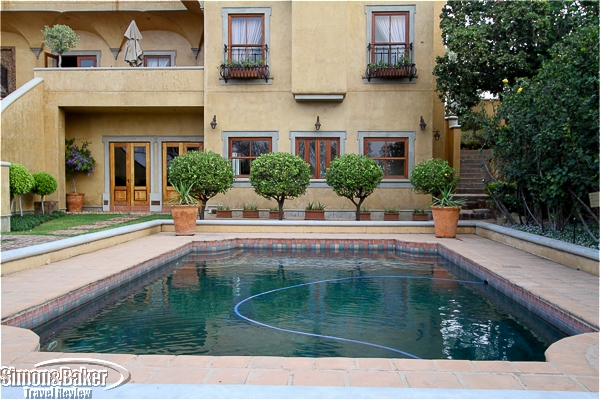
It was too chilly to swim in the pool
Although the Roman style charcoal granite pool looked inviting it was too cool outdoors to venture into the chilly water. Several guests relaxed poolside, but like me none went for a swim. From the rooftop the hotel had splendid views of the surrounding residential area and the city below.

Outdoor chess with a view at Castello di Monte
I spent the night like an Italian queen, sleeping on the comfortable four poster bed and waking up rested when my alarm call rang. After a brief continental breakfast (a hot breakfast was available, but given the 15 minutes between the breakfast service opening and departure time I opted for a light meal) I climbed aboard the transfer van with four Americans also traveling on The Blue Train to Cape Town.

The central marble staircase
Should I return to Pretoria on a leisure visit the Castello di Monte (402 Arles Street, Waterkloof Ridge, Pretoria, 0181, South Africa, +27 012 346 6984, www.castello.co.za, info@castello.co.za) will be at the top of my list. I was pleased with my experience there I already recommended the bed and breakfast property to fellow travelers aboard the train as well as some I met in Cape Town.
Happy New Year!

We wish you a New Year full of health, love, laughter, abundance and wonderful travel experiences!


